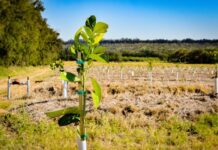By: Dr. Nimrod Israely – Founder and CEO – Biofeed Ltd
As you know, I encourage the increase of fresh fruit export; mainly produce with high added value when sold at premium international markets.
Fresh produce exports are the fastest, most powerful, economical, and sustainable way to transfer wealth from developed markets to farmers in emerging markets and to provide those developed markets with quality, healthy food.
THE #1 DREAMS KILLER IS FEAR!
This week Mr. Raviteja Reddy Bhimavarapu, an Indian agronomist, contacted me on LinkedIn (which gives me an opportunity to invite you to join me on LinkedIn as well), with a question that is exposing a fear shared by millions of farmers and tens of countries.
Mr. Bhimavarapu wrote to me: “Hi Sir, how to deal with constant changes in regulations? As obtaining export quality is expensive and labor-intensive in some cases. With any sudden change in regulation will be a disaster. Genuinely interested to know your views. Thanks in advance.“
Mr. Bhimavarapu wants to export because he understands that export promises higher income and offers a better economic future.
On the other hand, he fears that some regulatory requirements will be, once again, exacerbated, and he will not be able to export. As a direct result, he will lose his investment and the opportunity to utilize his investment and work.
The fear of not standing to the regulatory requirements needed for export,
is common and shared across the board by farmers, advisers, exporters, and decision-makers.
Its result is a paralyzing reaction that is keeping tens of millions of farmers in poverty, and preventing countries from improving the agri-industry and their economy.
Hence, for many farmers and potential exporters, attempts and efforts to export fresh agricultural produce are too often kept as a faraway untouchable dream, that dies a long time before any serious attempt is put to realize those dreams.
THE OTHER SIDE IS IN FEAR AS WELL
Tens of countries suffer daily and losing billions $ because Quarantine Pests made their way in and ruin their agro-industry, and with it the livelihood of millions.
A good example will be Bactrocera dorsalis, originated from Southeast Asia it is now all over Asia, Africa and parts of America and Oceania, leaves a trail of destruction worth billions of dollars.
The regulators are responsible to do their best to prevent such incidents. That is not all, they have another responsibility, and that is for public health.

The public awareness of chemical residues in its food is rapidly growing, and the regulator must answer its demand for safer and healthier food.
The result is a continuous introduction and updating of regulations that are meant to guard the above Economic and Health interests.
The result is that Exporters and Regulators live in a steady-state of fear, and fear is calling the regulators for drastic measures and actions.
Such is the case with COVID-19, whereas a result of fear regulators decided to put people and countries under total lockdown for months!
Similarly is the case with Quarantine Pests and Chemical Residues.
When Regulators are afraid they do not ask questions, they take the extreme decision and act fast by totally banning import.
Therefore, exporters and exporting countries must be ready to prevent even a single incident of quarantine pests or chemical residue interception.

QUESTIONS
What do you think; should Mr. Bhimavarapuyou start activities to export, or maybe not?
Is there a way to alleviate his worries, at least to some extent?
THE PROBLEM
In order for us to help, we must understand what is the main problem.
• Does Mr. Bhimavarapuyou argue that Economically it is worthwhile to export?
• Does Mr. Bhimavarapuyou claim that from a Professional point of view export is not possible?
• Does Mr. Bhimavarapuyou claim that he is unable to achieve Export Quality?
• Is Mr. Bhimavarapuyou claiming a problem with the Target Markets?
What Mr. Bhimavarapuyou says is that he fears of not being able to meet the new and updated exacerbated regulation, which is the result of the regulators’ and public increasing safety demands.
He also fears that the costs associated with meeting the future required quality will make exports not worthwhile.
You see, Mr. Bhimavarapuyou’s problem is – the fear of the unknown future regulations, and the related economic impact and how it may inflict him.
Can we help Mr. Bhimavarapuyou solve his fear resulting from the uncertainty of future regulations and their economic impact? If so how can we do it?
Darkness wins when there is no light.
So, let’s bring some light, or as I call it; information and knowledge to enable us to deal with a higher certainty with the expected future uncertainty.
CONQUERING FEAR
Fear is a serious “illness”. It prevents us from trying new things, making changes, progress, and eventually enjoying the Good we could create for us and everybody else.
Without progress, we don’t move forward. Practically, we are going backward, we lose, our family loses, the state loses and … the consumers as well. Everybody losses.
In order to progress, we must first defeat fear!
WHAT DOES IT TAKE TO EXPORT?
Exported produce creates many economic benefits to the local economy- thanks to growing premium quality produce, farmers are able to get a premium price, and consumers get premium healthy food.
Typically, higher quality market demands enable the farmer to receive a higher premium price for the same produce. In the absence of economic advantage, no export will take place.
Basically, anyone can export if he stands up to the following basic requirements and demands:
1. He has the desired produce, and
2. It stands up to the phytosanitary strict regulations and demands of the importing country. Although it varies between countries, there are two main types of demands that are repeating in different variations –
(a) Free of chemical residues. The threshold of MRL (Minimum Residue Level) varies across countries.
(b) Free of quarantine pests. The list of quarantine pests varies across countries.
That is it!! You stand up to the above rules and you are halfway to your dream export markets. Simple and easy as that!.
And this is my answer to Mr. Bhimavarapu – you have nothing to fear from as long as you make sure to comply with the above two demands.
THE MOST PERMANENT AND MOST ANTICIPATED CHANGE
But this is not enough for Mr. Bhimavarapuyou, as he is afraid of future “sudden change in regulation (that) will be a disaster“.
Mr. Bhimavarapuyou is afraid of the future, sudden, unexpected, stricter standards that maybe he will not be able to meet.
Look, public demand continuously pushes the regulator to toughen the regulations in these two topics –
(a) Free of chemical residues.
(b) Free of quarantine pests.
The regulators fear is causing the situation that even if you do not know the pace at which regulatory requirements will be toughened, you know for sure it will happen.
Hence, you can prepare in time and be ready for the exacerbation of regulation, whenever it happens.
You can expect that future regulatory demands will be for an even lower MRL, and with less tolerance for the interception of quarantine pests.
And one other thing, you can also expect to see the list of quarantine pests lengthen.
EVERYTHING IS EXPECTED
Now that we understand and can expect future regulations directions, what advice can we give Mr. Bhimavarapuyou so he can better deal with future “sudden change in regulation“?
Mr. Bhimavarapuyou should direct his actions to achieve quality produce higher than the current highest quality demands required in the target market.
Mr. Bhimavarapuyou should direct in advance, all his activities to deliver and match the quality demands above and higher than the current highest quality threshold.
In this case, when regulatory requirements exacerbate, Mr. Bhimavarapuyou will be ready and will not be affected or worried.
On the contrary, he will gain a competitive advantage against those who had not looked forward and had not prepared themselves for the exacerbation of regulations.

Figure 1: Value of produce as a function of its quality and investment. In order to achieve Low Export Quality, the main investment required is into Infrastructure. Further improvement of Export Quality produce, hence its market and business added value, can be achieved by improving the Management and Knowledgetools and ability. |
| From an economic point of view (Figure 1) the main type of investment required for moving up the ladder from Low to Top Export Quality is not in Infrastructure, but rather in Management and Knowhow. Many times I see grandiose agricultural projects in which the government has invested huge sums in infrastructure, but economically and business-wise the project has failed. Figure 1 gives the explanation; no matter how much we invest in infrastructure, without quality management and knowledge, the project will fail. The same is true for any other project and for sure for export projects. Studies show that the impact of improving the quality of management and knowhow is far greater than the impact of changes in infrastructure on the Value of Produce. |
CONCLUSIONS FOR EVERYBODY
If you wish to export fresh produce (like Mr. Bhimavarapuyou does) and do it with as little risk as possible, then you should –
1. Invest the minimum needed in Infrastructure, and as much as possible on getting the best quality Management and Knowhow.
The last, Management and Knowhow, are responsible for your ROI, hence the added value of your produce.
2. Make sure your produce is 100% free of quarantine pests and chemical residue. If this is the case then you can sleep well at night.
However, if that is not the case, don’t export! I repeat – you do not export if you have unclosed issues with quarantine pests or chemical residues. Instead, you first resolve your Quarantine Pests issue.
Note, phytosanitary issues are the ‘hottest’ issue for consumers and regulators in developed and emerging markets as one.
Trying to push, under the radar, produce that is not aligned with the required regulations is like playing with fire. Don’t do it!
Now Mr. Bhimavarapuyou you got all the basics that there is to know about being an exporter, and so there is no place for fear.
Sit down with your team, analyze your status, and your ability to become a great exporter and stand up to the above requirements.
Remember, the higher the quality of your produce, the greater is the added value that you have created. Thrive to export only Top Quality produce.
But there is one more thing that you should know about export…
BE A TOP EXPORTER
You know how hard it is for a farmer to become an Exporter. It is surely harder to become a Top Exporters.
Is it worth the investment to become a Top Exporter? Maybe a Medium Exporter is good enough?
The answer to that dilemma is clear when looking at Figures 1 and 2.
In Figure 1 we see that Top Quality produce receives the greatest price (value), while Figure 2 (below) presents the fact that only a few farmers are able to achieve Top Export produce.
From a business perspective, it means that once you achieve the goal of Top Quality produce, you have (a) very little competition, and (b) the highest price per Kg.
That is a wonderful bonus; a high price and little competition. Don’t you think so?
More… bit.ly/FreeDomeOutlook









